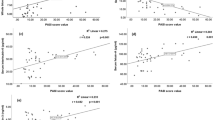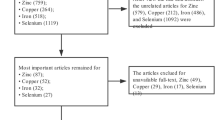Abstract
Psoriasis is an autoimmune skin disease characterized by hyperproliferation of keratinocytes due to interplay between keratinocytes and immune cells. Iron status plays an important role in modifying the function of the immune system. Heme oxygenase (HO), heme-degrading enzyme, plays important role in protective response to oxidative cellular stress. We aimed in this study to map the iron status and HO levels and declare the role HO enzyme in iron homeostasis and immune-modulation in psoriasis. Fifty-one patients with psoriasis and 50 age- and sex-matched healthy controls were enrolled in this study. 5 mL blood sample was withdrawn from each subject. Hepcidin, iron soluble transferring receptor (sTfR), and total iron binding capacity (TIBC) were estimated using ELISA technique and, HO-1 gene level was detected using RT-PCR (reverse transcription—polymerase chain reaction). Iron levels, TIBC, and hepcidin were significantly lower in cases compared to controls. On the contrary, sTfR and HO-1 were significantly over-expressed in cases compared to controls (p < 0.05 in all). HO-1 expression negatively correlated with PASI score and disease extent (%) (r = − 0.614-, p = 0.001; r = − 0.807-, p = 0.001 respectively). There were no significant associations between HO-1 expression and iron, TIBC, hepcidin, sTfR levels (p > 0.05 in all). Iron supplements for the patients with psoriasis are important to maintain haematopoiesis. The induction of HO-1 might have be a promising approach for the treatment of psoriasis through antioxidant ability, immunomodulatory role as well as its role in heme synthesis.
Similar content being viewed by others
References
Akamatsu Y, Haga M, Tyagi S et al (2004) Heme oxygenase-1-derived carbon monoxide protects hearts from transplant associated ischemia reperfusion injury. FASEB J 18:771–772
Albanesi C, Scarponi C, Bosisio D, Sozzani S, Girolomoni G (2010) Immune functions and recruitment of plasmacytoid dendritic cells in psoriasis. Autoimmunity 43(3):215–219
Applegate LA, Noel A, Vile G, Frenk E, Tyrrell RM (1995) Two genes contribute to different extents to the hemeoxygenase enzyme activity measured in cultured human skin fibroblasts and keratinocytes: implications for protection against oxidant stress. Photochem Photobiol 61:285–291
Briganti S, Picardo M (2003) What’s new. J Eur Acad Dermatol Venerol 17:663–669
Chan YH (2003) Biostatistics 104: correlational analysis. Singap Med J 44(12):614–619
Cullis JO (2011) Diagnosis and management of anemia of chronic disease:current status. Br J Haematol 154:289–300
Dilek N, Dilek AR, Sahin K, Kaklikkaya N, Saral Y (2014) Hepcidin expression in psoriasis patients. Indian J Dermatol 59(6):360
Ghio AJ, Schreinemachers DM (2016) Heme oxygenase activity correlates with serum indices of iron homeostasis in healthy nonsmokers. Biomark Insights 11:49–54
Goodnough LT, Nemeth E, Ganz T (2010) Detection, evaluation, and management of iron-restricted erythropoiesis. Blood 116:4754–4761
Hanselmann C, Mauch C, Werner S (2001) Haem oxygenase-1: a novel player in cutaneous wound repair and psoriasis. Biochem J 353:459–466
Kalantar-Zadeh K, Rodriguez RA, Humphreys MH (2004) Association between serum ferritin and measures of inflammation, nutrition and iron in haemodialysis patients. Nephrol Dial Transplant 19:141–149
Lee BS, Shim SM, Heo J, Pae HO, Seo BY, Han SY, Sohn DH, Jang SI, Chung HT (2007) Wogonin suppresses TARC expression induced by mite antigen via hemeoxygenase 1 in human keratinocytes: suppressive effect of wogonin on mite antigen-induced TARC expression. J Dermatol Sci 46:31–40
Leveque N, Robin S, Muret P et al (2004) In vivo assessment of iron and ascorbic acid in psoriatic dermis. Acta Dermatovenereol 84:2–5
Mast AE, Blinder MA, Gronowski AM et al (1998) Clinical utility of the soluble transferrin receptor and comparison with serum ferritin in several populations. Clin Chem 44:45–51
Mostert V, Nakayama A, Austin LM et al (2007) Serum iron increases with acute induction of hepatic heme oxygenase-1 in mice. Drug Metab Rev 39(2–3):619–626
Nemeth E, Rivera S, Gabayan V et al (2004) IL-6 mediates hypoferremia of inflammation by inducing the synthesis of the iron regulatory hormone hepcidin. J Clin Investig 113:1271–1276
Omara FO, Blakley BR (1994) The effects of iron deficiency and iron overload on cell-mediated immunity in the mouse. Br J Nutr 72:899–909
Pelle E, Mammone T, Maes D, Frenkel KV (2005) Keratinocytes act as a source of reactive oxygen species by transferring hydrogen peroxide to melanocytes. J Investig Dermatol 124:793–797
Ponikowska M, Tupikowska M, Kasztura M, Jankowska EA, Szepietowski JC (2015) Deranged iron status in psoriasis: the impact of low body mass. J Cachexia Sarcopenia Muscle 6(4):358–364
Poss KD, Tonegawa S (1997) Hemeoxygenase 1 is required for mammalian iron reutilization. Proc Natl Acad Sci USA 94(20):10919–10924
Prystowsky JH, Orologa A, Taylor S. Update on nutrition and psoriasis. Int J Dermatol 32:582–586
Ramos E, Kautz L, Rodriguez R, Hansen M, Gabayan V, Ginzburg Y, Roth MP, Nemeth E, Ganz T (2011) Evidence for distinct pathways of hepcidin regulation by acute and chronic iron loading in mice. Hepatology 53:1333–1341
Rashmi R, Yuti AM, Basavaraj KH (2012) Enhanced ferritin/iron ratio in psoriasis. Indian J Med Res 135:662–665
Ryter SW, Choi AMK (2016) Targeting heme oxygenase-1 and carbon monoxide for therapeutic modulation of inflammation. Transl Res 167:7–34
Wagener FA, van Beurden HE, von den Hoff JW, Adema GJ, Figdor CG (2003) The heme–heme oxygenase system: a molecular switch in wound healing. Blood 15:521–528
Zhang B et al (2016) Heme oxygenase-1 induction attenuates imiquimod-induced psoriasiform inflammation by negative regulation of Stat3 signaling. Sci Rep 6:21132
Funding
None.
Author information
Authors and Affiliations
Corresponding author
Ethics declarations
Conflict of interest
The authors declare that they have no conflict of interest.
Ethical approval
The study was approved by the local research ethics committee of the Faculty of Medicine, Beni Suef University.
Informed consent
The purpose of the study was explained to each patient, and a written informed consent was taken before data collection.
Rights and permissions
About this article
Cite this article
El-Rifaie, AA.A., Sabry, D., Doss, R.W. et al. Heme oxygenase and iron status in exosomes of psoriasis patients. Arch Dermatol Res 310, 651–656 (2018). https://doi.org/10.1007/s00403-018-1852-6
Received:
Revised:
Accepted:
Published:
Issue Date:
DOI: https://doi.org/10.1007/s00403-018-1852-6




